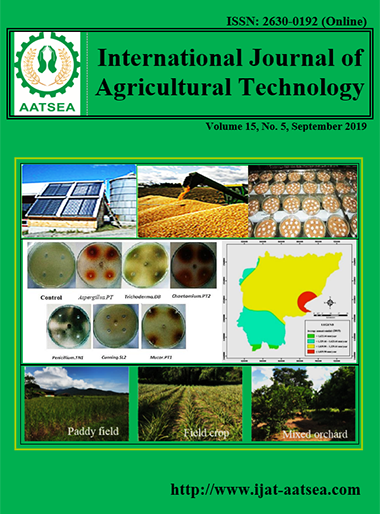The influence of El Nino on water shortage area in Sa Kaeo province, Thailand by using GIS
Main Article Content
Abstract
The influence of El Nino on the area of land impacted by water shortage in Sa Kaeo Province, Thailand was recorded by using Geographic Information System (GIS). As results, the normal conditions revealed that water shortage based on many criteria, average annual rainfall from 30 years, volume of groundwater, distance of water and irrigation sources, soil drainage, slope, and land use. In the year with El Nino phenomenon, the studied criteria were resulted as the same as normal years, except rainfall data from 2015, because it is strated to faced this phenomenon in Thailand. The results indicated that El Nino influenced the degree of water shortage in area of Sa Kaeo Province. The total area with moderate and low water shortage decreased, while the area with high and very high water shortage increased as compared to normal years. The high water shortage area increased from 3,406.19 km2 to 4,489.80 km2 (15.06%). The very high water shortage area increased from 203.17 km2 to 762.22 km2 (7.77%). Preparation of mitigate, the effects of drough from El Nino can should be separated into three phases; before, during, and after. Before an El Nino year, relevant government agencies should determine agricultural production targets in drought condition and plan irrigation management. During the El Nino year, activities should include the monitoring of weather condition and water suppy, Royal rain-making operations, water allocation planning, support for agricultural production, and damage survey for assistance and subsidy. After the phenomenon, mitigation and careers revitalization should be appropriately offered to people in area affected by water shortage.
Article Details

This work is licensed under a Creative Commons Attribution-NonCommercial-NoDerivatives 4.0 International License.
References
Alam, J. B., Nahar, T. and Shaha, B. (2008). Evaluation of national highway by geographical information system. International Journal of Environmental Research, 2:365-370.
Faryadi, Sh. and Taheri, Sh. (2009). Interconnectiiions of urban green spaces and environmental quality of tehran. International Journal of Environmental Research, 3:199-208.
Kripalani, R. H. and Kulkarni, A. (1997). Rainfall variability over souh-east Asia-connections with Indian monsoon and ENSO extremes: New perspectives. International Journal of Climatology, 17:115-1168.
Lorpittayakorn, P. (2017). The influence of El Nino on rainfall distribution during wet and dry seasons in eastern Thailand. Thai Science and Technology Journal, 25:944-959.
Lema, M. A. and Majule, A. E. (2009). Impacts of climate change, variability and adaptation strategies on agriculture in semi arid areas of Tanzania: The case of Manyoni District in Singida Region, Tanzania. African Journal of Environmental Science and Technology, 3:206-218.
Mahiny, A. S. and Gholamalifard, M. (2007). Dynamic spatial modeling of urban growth through cellular automata in a GIS Environment. International Journal of Environmental Research, 1:272-279.
NASA Official (2019). Monthly NINO3.4 Index data Available Source. Retrieved from http://www.cpc.ncep.noaa.gov/data/indices/sstoi.indices.
Nectec (2019). Khok Nong Na model. Retrieved from http://nectec.or.th/news/news-pr-news/Khoknongna.html.
Nounmusig, W., Wongwises, P., Zhang, M., Sukawat, D. and Chidthaisong, A. (2006). Effects of ENSO on precipitation over Northeast Thailand during rainy season 1997-1999. In: Proceeding of the 2nd Joint International Conference on Sustainable Energy and Environment (SEE 2006), Bangkok, Thailand.
Otarig, C. (2000). Assessment of El Niño Impact on Rainfall over Thailand. (Master Thesis). Thammasat University. Bankok, Thailand.
Pijanowski, B. C., Tayyebi, A., Delavar, M. R. and Yazdanpanah, M. J. (2009). Urban expansion simulation using geospatial information system and artificial neural networks. International Journal of Environmental Research, 3:493-502.
Sa Kaeo Disaster Prevention and Mitigation Office (2017). Disaster declaration, Sa Kaeo Province, 2016. Retrieved from http://122.155.1.141/downloaldetial.skw-4.173/10377/menu.
Setimela, P., Gasura, E., Thierfelder, C., Zaman-Allah, M., Cairns, J. E. and Boddupalli, P. M. (2018). When the going gets tough: Performance of stress tolerant maize during the2015/16 (El Niño) and 2016/17 (La Niña) season in southern Africa. Agriculture, Ecosustems and Environment, 268:79-89.
Shrestha, A. and Kostaschuk, R. (2005). El Niño/Southern Oscillation (ENSO) related variability in mean-monthly streamflow in Nepal. Journal of Hydrology, 308:33-49.
Solaimani, K., Mohammadi, H., Ahmadi, M. Z. and Habibnejad, M. (2005). Flood occurrence hazard forecasting based on geographical information system. International Journal of Environmental Science and Technology, 2:253-258.
Tangtham, N., Tantasirin, C. and Techamahasaranont, J. (1999). Floods and droughts of the lower chao phraya river basin in relation to ENSO events and land use/land cover changes. In: Proceeding on The ’99 workshop on GAME-T in Thailand, 8-9 March. Kanchanaburi, Thailand:NSC for GAME-T and JSC for GAME.
Thai Meteorological Department (2017). Climate Change. Retrieved from http://www.tmd.go.th/Info/info.php?FileID=86.
Ueangsawat, K., Nilsamranchit, S. and Jintrawet, A. (2015). Fate of ENSO phase on upper northern Thailand, a case study in Chiang Mai. Agriculture and Agricultural Science Procedia, 5:2-8.


